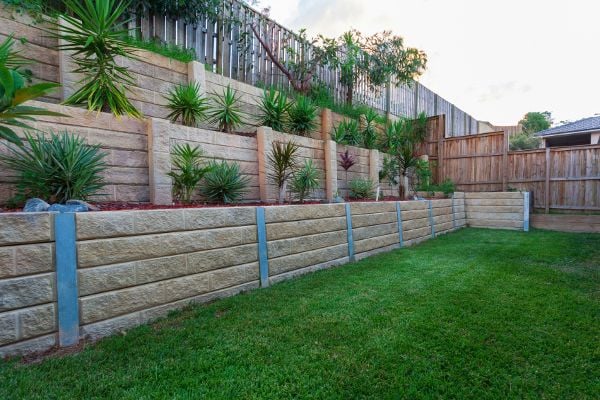How To Make A Terraced Garden
Even if the topography of your yard curves into a steep slope, planting can still be possible on this unique kind of landscape. By installing a terrace garden, you can essentially break the large, angled slope into a series of smaller levels that are flattened like a step pyramid and make the area garden friendly.
By reshaping the sloped soil in this way, you're also creating a system where rainwater soaks into the soil rather than rolling down it. This prevents soil runoff or erosion.
What Material Should You Use?
There are a variety of materials that will do the job, but two are most common.
Pressure Treated Wood
One of the best materials for building your own terrace is treated wood. Treated wood, also known as pressure treated wood is easy to work with, blends well with plants, and is often less expensive than other materials. Most of all, this stuff lasts and has a long lifespan. There are many types of treated wood on the market--from railroad ties to landscaping timbers all of which will last for years.
If there's an alert going off in the back of your mind right now about the dangers associated with treated wood, including harmful chemicals like arsenic and chromated copper arsenate (CCA), don't be concerned. Such chemicals were used in the construction of pressure treated wood at one time, but that was decades ago. The Environmental Protection Agency has since outlawed the use of these things and modern treated wood is made with a different, less harmful compound. Outside of the U.S. this may still be a concern, but overall, any arsenic levels present are likely negligible.
Masonry
Other possible materials for terraces include bricks, rocks, concrete blocks, and similar masonry. Some masonry materials like field stone or brick are even made specifically for walls and terraces. This means they'll be much easier for you to work with if you don't have any experience with this type of work. However, one drawback is that most stone or masonry products tend to be more expensive than wood.
Building the Terrace

The safest and most popular way to build a terrace is the cut and fill method. This technique leaves most of the soil undisturbed, giving you protection from erosion should a sudden storm occur while the work is in progress. The cut and fill method also doesn't require much in terms of the influx or buying of additional soil.
Step 1 - Know Your Building Codes and Surroundings
Contact your local authorities to find out if there are any utility wires nearby or hidden beneath the layers of soil on your hillside. They can also fill you in on local building codes. Many areas have building codes specifically pertaining to terraces and walls. If your terrace walls are considerably large, their construction must be reviewed by an expert to ensure the walls can stand up to water pressure in the soil, have proper drainage, and are safely incorporated with the rest of the hillside.
Because of the expertise and equipment required to do this correctly, restrict terraces you build yourself to no more than 1-2 feet high, depending on the limits in your local codes.
Even if you don't want to hire a landscape contractor to do the work, it's never a bad idea to consult with an expert who can offer several ways to approach your unique slope and help you choose the right terrace solution for your landscape and your budget.
Step 2 - Measure and Plot Individual Terraces
Determine the rise and run of your slope.
The rise is the vertical distance from the bottom of the slope to the top. The run is the horizontal distance between the top and bottom. Knowing these numbers will help you determine how many terraces you can ideally construct in the space and how large each one will be. For example, if your run is 20 feet and the rise is eight feet and you want each bed to be five feet wide, you need four beds. The rise of each bed will be two feet.
Step 3 - Dampen Soil

In the 24 hours leading up to you breaking ground, water the soil at the base of the hillside with a hose. You don't want to soak the dirt and turn it muddy, but if things are slightly damp it will prevent you from getting dusted out once you start digging and shifting soil.
Step 4 - Dig the Horizontal Base
Dig a trench along the horizontal base of the slope. The depth of this base should be equal to the radius of whatever landscaping material you'll be using. For example, if you're using landscape timbers and your terrace is low (less than two feet), you only need to bury the timber to about half its thickness or less. The width of the trench should be slightly wider than your timber. Essentially, your trench depth will vary depending on how tall you want your terrace to be.
Make sure the depth is level and consistent throughout the entire length of the trench. If you find any uneven spots, add or remove the necessary soil with a hand trowel.
Once things are at an even depth, tamp down the soil at the bottom of the trench to compact it.
TIP: You may want to keep a wheelbarrow handy to help store and transport any excess soil from digging the trenches.
Step 5 - Place Your Walls
Measure the length of the trench you just made. Cut a length of timber or masonry product that matches the length of the trench. If the trench itself is longer than any one length of timber or masonry, use more than one length and cut any you have to in order to span the entire trench length.
Place these lengths inside the trench end to end to form the base of the retaining wall for your terrace.
WARNING: Make sure to follow the manufacturer's instructions carefully when using masonry products. Many of these have limits to the number of tiers or the height that can be safely built.
Step 6 - Dig Out the Sides

The sides of your terrace will be made up of two trenches that extend from opposite ends of the first trench you dug and form two 90-degree angles. To make things clearer, when both the front trench and sides are dug out, your hill should look like it is encased in a three-sided box or U shape.
Unlike the front trench, which has a depth equal to half the diameter of the wall timbers, the side trenches should be deeper than the measure of their timbers by exactly one inch. For example, when you place your timbers the way they're going to be positioned when set into the terrace you find they have a height of two feet, dig your side trenches a depth of that same two-foot diameter, and add one inch. Your total depth in this scenario would be 25 inches.
The extra inch on the side is there to leave room for a stabilizing spike to be driven through the timber and into the ground. Unlike the horizontal base trench, which is laying on flat ground, the side trenches and their retaining walls will be set into the slope. The spike helps them maintain their position.
Step 7 - Build up the Side Walls and Add Stabilizing Spikes
Cut a timber or timbers to the correct length and place them in each side trench. Drill holes through your timbers and pound long galvanized spikes or pipes through the holes and into the ground. An 18-inch pipe minimum length is recommended; longer pipes may be needed for stability for higher terraces. Place the next tier of timbers on top of the first, overlapping corners and joints so they are staggered like bricks. Run spikes through this tier as well and into the previous one to join the timbers.
Step 8 - Top Spike Placement
Whenever you reach your top layer of timber which will depend on how tall you make your terrace walls, place a minimum of three spikes in it, taking care to position the spikes in different spots than you did on your bottom most length of timbers. If the spikes at both the top and the bottom layers line up, it can compromise the stability of your wall.
Step 9 - Fill the Area with Soil
Move soil from the back of the bed to the front of the bed until the surface is level and the timbered enclosure is filled. This process of taking soil from the rear of the slope, where more walls are terraces still need to be built and filling in the front terrace, is known as backfilling.
This is a great time to add soil amendments, such as compost.
Step 10 - Construct Additional Terraces
Repeat the process, starting with Step 4. In continuously connected terrace systems, the first timber of the second tier will also be the back wall of your first terrace. The back wall of the last bed will be level with the front wall of that bed. When finished, plant and mulch.
While the entire purpose of putting in a terrace garden was to transform the steep curved hill into something flatter and more rigid, it's possible that even when things start to grow in you may not like the look of the sharp angles and edges between your terrace levels.
Our expert gardening advisor Kathy Bosin suggests using low creeping perennials at the edge of terraces "to cascade over the hardscape, softening the edges of your terraces. Good choices include creeping phlox, thyme, and sedums."
Other Options for Slopes

There are other solutions to control ground erosion.
Groundcover
If terraces are beyond the limits of your time or money, you may want to consider other options for backyard slopes. If you have a slope that is hard to mow, consider using groundcovers other than grass. There are many plants adapted to a wide range of light and moisture conditions that require little care, but provide soil erosion protection.
Stripcropping
Stripcropping is another way to deal with long slopes. Rather than terracing to make garden beds level, plant perennial beds and strips of grass across the slope.
Once established, many perennials are effective in reducing erosion. Mulch also helps reduce erosion. The erosion that may occur will be primarily limited to the garden area. The grass strips act as filter strips and catch much of the soil that may run off the beds. Grass strips should be wide enough to mow across the hill easily as well as wide enough to effectively reduce erosion.
How To Make A Terraced Garden
Source: https://www.doityourself.com/stry/gardenterraces
Posted by: lewtercand1993.blogspot.com

0 Response to "How To Make A Terraced Garden"
Post a Comment